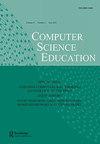社论
IF 2.2
Q1 EDUCATION & EDUCATIONAL RESEARCH
引用次数: 0
摘要
并展示微观世界的微小变化如何导致不同的教学重点。作者最后讨论了如何根据微观世界的情况定制代码分析的通用度量。在这样做的过程中,他们鼓励和支持那些希望将教育数据挖掘的原理和方法应用于涉及微世界和谜题的基于块的编程的研究人员。本文章由计算机程序翻译,如有差异,请以英文原文为准。
Editorial
and showcase how small variations of a microworld result in a different pedagogical focus. The authors conclude by discussing how to tailor general measures for code analysis to the case of microworlds. In doing so, they encourage and support researchers who want to apply principles and methods from educational data mining to the case of block-based programming involving microworlds and puzzles.
求助全文
通过发布文献求助,成功后即可免费获取论文全文。
去求助
来源期刊

Computer Science Education
EDUCATION & EDUCATIONAL RESEARCH-
CiteScore
6.90
自引率
3.70%
发文量
23
期刊介绍:
Computer Science Education publishes high-quality papers with a specific focus on teaching and learning within the computing discipline. The journal seeks novel contributions that are accessible and of interest to researchers and practitioners alike. We invite work with learners of all ages and across both classroom and out-of-classroom learning contexts.
 求助内容:
求助内容: 应助结果提醒方式:
应助结果提醒方式:


